-
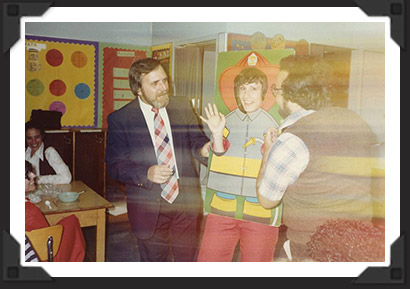
Last day as a teacher
Candidate Marianne Monahan was photographed in a firefighter cut-out on her last day of teaching before entering the FDNY in 1982. Many of the women who applied to the FDNY—like women aspiring to other traditionally male jobs—were spurred on by the dramatic difference in pay and benefits.
Courtesy of Marianne Monahan
-
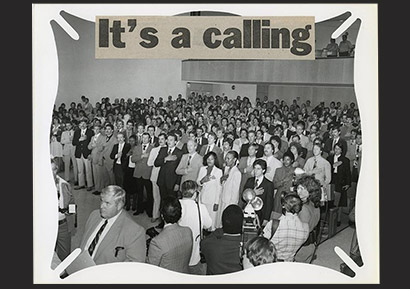
Swearing in ceremony
Photo of the 1982 swearing-in ceremony of the first FDNY class of probationary firefighters to include women (labeled by a supporter of one of the women). The auditorium at Murray Bergstrom high school was packed with candidates and their families, as well as an unusually heavy turnout of press. During the ceremony, people at the back of the room raised signs protesting the hiring of the women and conducted a demonstration.
Courtesy of Marianne Monahan
-
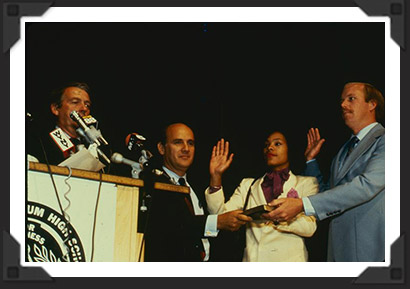
Taking the oath of office as a
probationary firefighterCandidate Katrina Cannon taking the oath of office as a probationary firefighter, representing the group of women, in 1982.
Courtesy of Tamiment Library
-
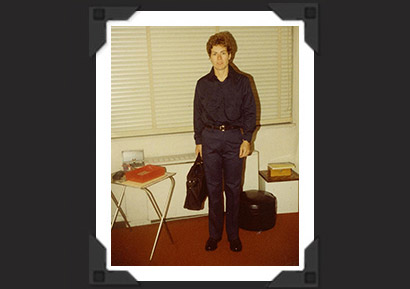
Ready for the first day of training
Brenda Berkman photographed as she prepared to leave for her first day at the FDNY Training Academy on Randall’s Island, September 25, 1982, wearing her probationary firefighter uniform and carrying her personnel papers and notebook. Berkman’s father-in-law and husband were the lawyers for the UFOA (Uniformed Fire Officers Association) union—until she won her case—at which point they were fired.
Courtesy of Tamiment Library
-
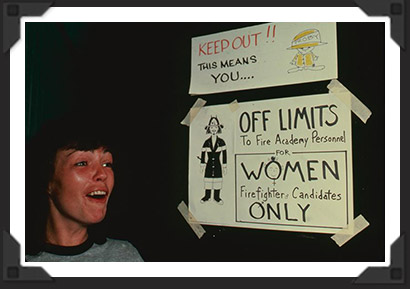
Women Only
Candidate Cathy Lohan alongside the hand-lettered sign designating the repurposed women’s locker room at the Training Academy in 1982. A women-only locker room was important in the hostile climate the trainees faced. One story from the first months (confirmed by several sources) describes a male probationary firefighter gathering newspaper articles featuring women firefighters into a pile and then urinating on them in front of several women firefighters. No disciplinary action was ever taken against the male “probie.”
Courtesy of Tamiment Library
-
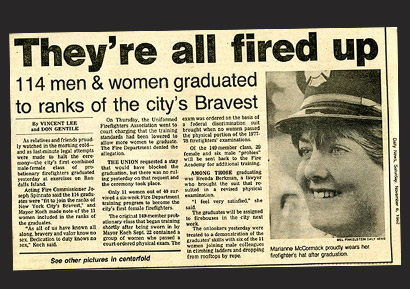
“Fit to join the ranks of New York City’s Bravest”
Marianne McCormack is featured in this respectful article from the Daily News, 1982, reporting on the graduation of the first 11 women (out of 40) from the Training Academy. Constantly changing requirements for graduation, as well as harassment and discrimination delayed the graduation of the other women—some by days, some by weeks. All the while, the firefighters union (UFA) continued to oppose the assignment of the women to firehouses. McCormack’s father was a fire marshal in the FDNY.
-
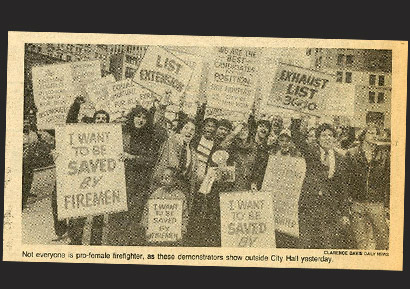
Not everyone is pro-female firefighter
Demonstrators carry signs reading “I want to be saved by firemen” and “We are the best candidates for the position of firefighters; Save the City of New York,” at this demonstration in front of city hall protesting the swearing in of women firefighters. The clipping is from the Daily News, November 6, 1982. Women who had just completed the rigorous training were being assigned to firehouses—but never more than one woman at any location, and never to a “slow” firehouse.
-
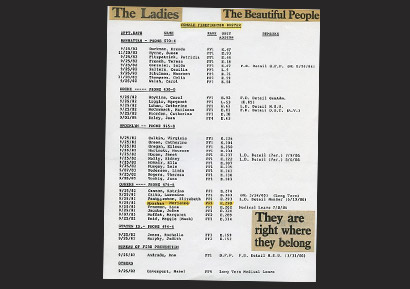
Roster of women firefighters
This list of the assignments of women firefighters several years after the hiring shows them spread throughout the City—with not one location housing more than one woman. Labeled by a supporter “The Ladies; The Beautiful People; They are right where they belong,” the list evokes the isolation and potential vulnerability to harassment the women experienced.
Firefighters spend between 9 and 24 consecutive hours in the firehouse. During this time they eat and sleep (when possible); take showers and change clothes after calls where they get dirty; train; maintain their equipment; do inspections; and relax. Bunkrooms in 1982 were typically one large room where everyone slept. Officers had separate bunkrooms. At first, the bathrooms, showers and changing facilities were for both genders. Flimsy locks were supposed to be installed on the bathrooms but those were often ripped off the wall.
Courtesy of Marianne Monahan
-
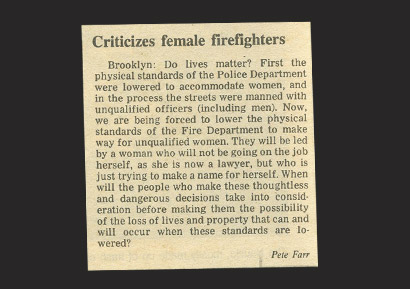
Editorial against women firefighters
This clipping of a 1982 editorial in the Daily News, and another letter to the editor, both oppose women firefighters. The editorial argues that standards had been lowered to admit the women, and snipes at Berkman (not by name) as not really wanting the job because she was a lawyer just “trying to make a name for herself.” Berkman went on to spend 25 years as a firefighter and fire officer, rising to the rank of Captain.
Courtesy of Marianne Monahan
-
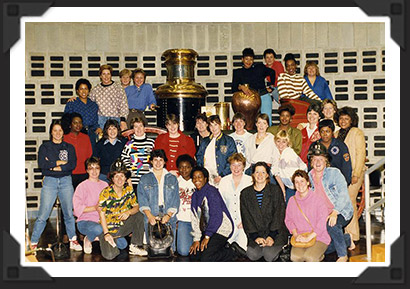
Group portrait of first women firefighters
A photo of the first group of women to be hired and graduate as FDNY firefighters (circa 1988). First row (left to right): Cathy Lohan, Brenda Berkman, Maureen McArdle Schulman, Maggie Mack (Reid), JoAnn Jacobs, Meg Liggio, Janet Horan, Margaret Moffat, Marianne McCormack; second row: Lois Mungay, Joan Daley, Marianne Monahan, Rocky Jones, Mary Toohig, Carol Walsh, Jane Toohig, Sidney Kelly, Teresa French, Susan Byrne, Ana Andrade, Cathy Riordan, Linore Gillison (Simmond), Eileen Gregan, Harriet Duran; back row: Lynn Freeman (Porter), Maureen Hartnett (Leo), Beth Featherston, Judy Murphy, Katrina Cannon, Pat Fitzpatrick, Cecelia Salters (Owens Cox), Lorraine Cziko. Missing from photo: Ginny Culkin (Spinelli), Mabel Davenport, Zaida Gonzalez (Ocasio), Ruth Russell, Celia Thompson.
Many of the women had family connections to the FDNY—their husbands, fathers, brothers or uncles were on the force (though many did not reveal this at the time, partly due to fear of potential retaliation against the women or their male relatives). Several of the women were stay-at-home moms; several were college students; other jobs women left to join FDNY included waitress, teacher, bar tender, attorney, executive assistant on Wall Street, baggage handler at JFK airport, transit cop, sales rep for a map company, fraud control for Merrill Lynch, and unspecified jobs at the Museum of Natural History and on Wall Street.
Courtesy of Tamiment Library
-
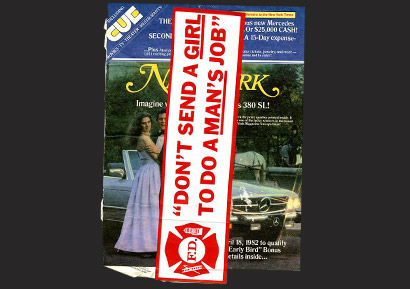
“Don’t Send a Girl to do a Man’s Job” bumper sticker
Opposition to women firefighters coalesced when some male firefighters formed an organization and issued this bumper sticker, which seemed to be pasted on virtually every male firefighter’s vehicle and posted throughout many firehouses.
Circa 1982, courtesy of Tamiment Library
-
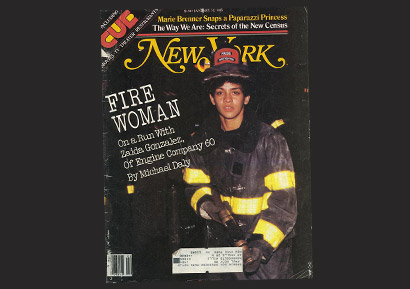
“Fire Woman”
Cover story in New York Magazine, January 10, 1983: “Fire Woman—On a Run With Zaida Gonzalez of Engine Company 60.” The story was relatively positive, chronicling her work as a firefighter in Engine 60. As a result of the publicity, however, Gonzalez was targeted for increased harassment and discriminatory acts.